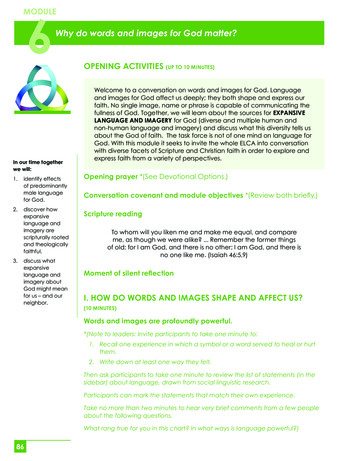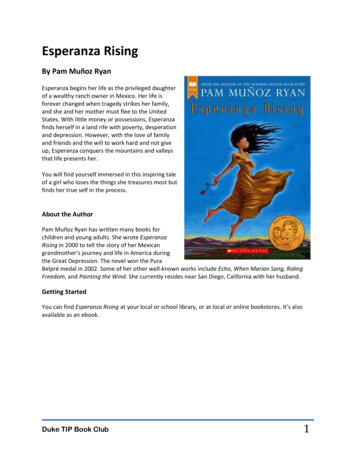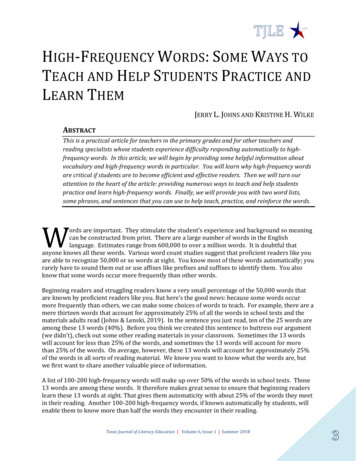
Transcription
6MODULEWhy do words and images for God matter?In our time togetherwe will:1.2.3.identify effectsof predominantlymale languagefor God.discover howexpansivelanguage andimagery arescripturally rootedand theologicallyfaithful.discuss whatexpansivelanguage andimagery aboutGod might meanfor us – and ourneighbor.OPENING ACTIVITIES (UP TO 10 MINUTES)Welcome to a conversation on words and images for God. Languageand images for God affect us deeply; they both shape and express ourfaith. No single image, name or phrase is capable of communicating thefullness of God. Together, we will learn about the sources for EXPANSIVELANGUAGE AND IMAGERY for God (diverse and multiple human andnon-human language and imagery) and discuss what this diversity tells usabout the God of faith. The task force is not of one mind on language forGod. With this module it seeks to invite the whole ELCA into conversationwith diverse facets of Scripture and Christian faith in order to explore andexpress faith from a variety of perspectives.Opening prayer *(See Devotional Options.)Conversation covenant and module objectives *(Review both briefly.)Scripture readingTo whom will you liken me and make me equal, and compareme, as though we were alike? . Remember the former thingsof old; for I am God, and there is no other; I am God, and there isno one like me. (Isaiah 46:5,9)Moment of silent reflectionI. HOW DO WORDS AND IMAGES SHAPE AND AFFECT US?(10 MINUTES)Words and images are profoundly powerful.*(Note to leaders: Invite participants to take one minute to:1. Recall one experience in which a symbol or a word served to heal or hurtthem.2. Write down at least one way they felt.Then ask participants to take one minute to review the list of statements (in thesidebar) about language, drawn from social linguistic research.Participants can mark the statements that match their own experience.Take no more than two minutes to hear very brief comments from a few peopleabout the following questions.What rang true for you in this chart? In what ways is language powerful?)86
Module 6: Why do words and images for God matter?Language and images about God affect faith.*(Note to leaders: Read or summarize the following introduction.)If everyday language is so powerful, think about religious language, inparticular, language and images for God. Words and images about Godmatter a great deal because they express understandings of who God is.Scripture is full of a variety of images and language about God. They arenot literal, and sometimes they are downright paradoxical.Language and images about God also affect our understanding ofourselves, both as individuals and as communities.*(Note to leaders: Divide the group in half and have one group read the first twostories and the other group read the third story. After reading their stories, groupsdiscuss the discussion questions. Gather as a large group and take about threeminutes to hear short answers from a few people.)Language andimages or symbols create powerdynamics. express truth. hurt people. heal people. shape ourunderstandingsof the world andourselves. influence peopleat an early age. are learned byrote in religiousrituals before weunderstand theirmeanings.1When we listen to the needs of others in the body of Christ, how can we bepastoral? How can we proclaim God’s love?While walking home after work, Ruth was raped by a strangerposing as a jogger. She was a teenager. Days afterward, hecalled her house, bringing more terror to her parents. He wasnever apprehended. Fear and anger covered her and her family.Many images of God fed them in their grief. Now an adult, Ruthis one of many survivors of violence who say that predominantlymale-identified language and images of God hurt. Instead, sheexperiences God’s love and healing through God as woman,God as mother, God like her.2A man in prison was visited by a young pastor who had beenassigned there by his seminary. The pastor tried to console the manby assuring him of the love of God the Father. The man stopped thepastor. “Don’t talk to me about a father’s love. I only saw my father afew times in my life, and each time he beat me. He abused me andmy mother and my sisters and brothers. That’s what I know of fathers.”3With great joy, we gathered for the baptism of our granddaughter,Hannah. Though I believe Scripture’s promise that Hannah is createdin the image of God, I was troubled that her baptismal serviceincluded only male and neutral language for God. Yes, I know thetheological and ecumenical reasons for baptizing in the name ofthe Father, Son and Holy Spirit; still I wondered why other parts of theliturgy didn’t include more expansive images for God (Mother of alllife; Holy Wisdom calling us to her table).87
Module 6: Why do words and images for God matter?And then I wondered: Would it be so surprising if Hannah were tostruggle more than her older brother in seeing herself in the divineimage? If the worship they experience uses mostly male pronounsand images to speak of God, wouldn’t it be entirely possible for ourgrandson to carry a deeper sense that he bears God’s image?To be sure, incorporating more expansive images for God doesn’tmean we abandon cherished prayers like the “Our Father.” Wesimply find other places to incorporate female images – images fromScripture – so that all people, including Hannah, may more clearlyhear the good news of God’s love for them.4II. WHAT LANGUAGE AND IMAGERY ABOUT GOD ARE INSCRIPTURE? (15 MINUTES)Scripture provides a variety of expansive language and images about God.When we seek to proclaim the good news of God’s love in Christ in waysthat minister to many people, we can turn to Scripture and theology forresources.*(Note to leaders: Divide the group into pairs or groups of three. Assign eachgroup a list of verses, either 1-6 or 7-13. If the group is working without a hardcopy of the entire study, make photocopies of the verses for handouts.Invite groups to:1. Skim the verses for a minute and notice how the images and languagemake you feel. Start to wonder why these particular feelings are evoked.2. Reflect on these questions together: What do you think these images say about God? What do you think these images say about humankind?After participants have read and discussed the verses, gather in a large groupand hear short responses from a few people.)88
Module 6: Why do words and images for God matter?1 “The Rock, his work is perfect, and allhis ways are just.” (Deuteronomy 32:4a)“You were unmindful of the Rock thatbore you; you forgot the God who gaveyou birth.” (Deuteronomy 32:18)“Indeed their rock is not like our Rock;our enemies are fools.”(Deuteronomy 32:31)2 “The LORD is my light and mysalvation; whom shall I fear?”(Psalm 27:1)3 The LORD says to Israel of those whoare wayward, “I will fall upon them likea bear robbed of her cubs, and willtear open the covering of their heart;there I will devour them like a lion, asa wild animal would mangle them.”(Hosea 13:8)4 Jesus says: “Jerusalem, Jerusalem,the city that kills the prophets andstones those who are sent to it! Howoften I have longed to gather yourchildren together, as a hen gathers herchicks under her wings, and you werenot willing.” (Matthew 23:37)5 “Which one of you, having a hundredsheep and losing one of them, does notleave the ninety-nine in the wildernessand go after the one that is lost untilhe finds it? . Or what woman havingten silver coins, if she loses one of them,does not light a lamp, sweep the house,and search carefully until she finds it?”(Luke 15:4,8)(For the full text, see Luke 15:1-10.)6 God says about Israel: “Yet it was Iwho taught Ephraim to walk, I who tookthem up in my arms; but they did notknow that I healed them. I led themwith cords of human kindness, withbands of love. I was to them like thosewho lift infants to their cheeks. I bentdown to them and fed them.”(Hosea 11:3-4)7 “You are a hiding place for me; youpreserve me from trouble; you surroundme with glad cries of deliverance.”(Psalm 32:7)8 Moses proclaims to all of Israel:“As an eagle stirs up its nest, and hoversover its young; as it spreads its wings,takes them up, and bears them alofton its pinions, the LORD alone guided[Jacob]; no foreign god was with him.”(Deuteronomy 32:11-12)9 “As the eyes of servants look to thehand of their master, as the eyes of amaid to the hand of her mistress, so oureyes look to the LORD our God, until hehas mercy upon us.” (Psalm 123:2)10 God says: “For a long time I haveheld my peace, I have kept myself stilland restrained myself; now I will cry outlike a woman in labor, I will gasp andpant.” (Isaiah 42:14)11 God says to Israel: “Listen to me, Ohouse of Jacob, all the remnant of thehouse of Israel, who have been borneby me from your birth; carried from thewomb; even to your old age I am he,even when you turn gray I will carry you.I have made, and I will bear; I will carryand will save.” (Isaiah 46:3-4)12 God says: “Can a woman forget hernursing child, or show no compassion forthe child of her womb? Even these mayforget, yet I will not forget you.”(Isaiah 49:15)13 God says: “As a mother comfortsher child, so I will comfort you; youshall be comforted in Jerusalem.”(Isaiah 66:13)89
Module 6: Why do words and images for God matter?At times, gender roles are subverted or mixed in Scripture.*(Note to leaders: Ask one or two people to read the following section aloudwhile the group follows along. Encourage participants to circle anything in thetexts that strikes them about gender roles. This exercise should take no more thana few minutes.)1. Paul describes himself as a mother in labor.“My little children, for whom I am again in the pain of childbirth until Christ isformed in you,” (Galatians 4:19)2. Jesus washes his followers’ feet. (John 13:1-20)“[Jesus] got up from the table, took off his outer robe, and tied a towelaround himself. Then he poured water into a basin and began to wash thedisciples’ feet and to wipe them with the towel that was tied around him.”(John 13:4-5)Biblical commentators have noted that the towel Jesus put on his waist wasthe symbol of those who washed other people’s feet: Jewish wives and slavegirls. Foot washing was done by females for males and symbolized a particularrelationship of either marital service and intimacy or servitude. Yet while footwashing was an act of hospitality, love and honor, it was simultaneously “anunequivocal signal of hierarchical power relationships.” The husband does notdo this for the wife. A Jewish male slave would not do this for anyone because ofthe problems of defilement, even though a slave. A free man would never washanother’s feet.5This subversion is exactly what is happening in the text. What Jesus does offendsthe disciples specifically because his activity is a female’s role! Jesus disruptedaccepted gender roles. Jesus was gender non-conforming and put on thesymbol of these women, a towel at the waist. Even more scandalous, Jesus tellsthe disciples that they, too, should wash each other’s feet!As we move from Scripture to written and visual theology, keep these “genderparadoxes” in mind. You will have a chance to reflect on these in a few minutes.III. IN WHAT WAYS HAVE THEOLOGIANS USED SCRIPTURE TOSPEAK ABOUT GOD? (7 MINUTES)*(Note to leaders: Skip this portion if you have less than one hour for the module.Invite someone to read the following quotations from theologians in the earlychurch and during the medieval period. Point out that what they say is rooted inScripture. Encourage participants to underline sections that attract their attentionand circle anything that challenges traditional gender roles or ideas.)90
Module 6: Why do words and images for God matter?“Holy Divinity has lost her coins, and it is us!”St. Augustine of Hippo (354-430)6(based on Luke 15:8)“But you, Jesus . Are you not that mother who, like a hen collects her chickensunder her wing? Truly master, you are a mother.”St. Anselm of Canterbury (1033-1109) in Prayer 10 to St. Paul, “Opera Omnia” 3:33and 39-41(based on Matthew 23:37)“A mother can hold her child tenderly to her breast, but our tender mother,Jesus, can lead us in friendly fashion into his blessed breast by means of hissweet open side.”Julian of Norwich (1342-c. 1416) in “Revelations of Divine Love,” Chapter 60, para. 6(based on Isaiah 46::3-4; 49:15)“The Bridegroom, Christ . has breasts, lest he be lacking any one of all the dutiesand titles of loving kindness. . He is a mother, too, in the mildness of his affection.”Bernard of Clairvaux (1090-1153) in “Sermons 2,” Second sermon for St. Peter andSt. Paul, Chapter 2, 384-86(based on Isaiah 49:15 and Mark 2:20)Questions for discussion in the full groupThe Scripture and expressions of faith you have studied here express paradoxesabout gender roles and identities. Together, name at least three ways this mightaffect how we understand God.IV. WHAT ARE SOME EXAMPLES OF THE WAYS ARTISTS EXPRESSSACRED TRUTH IN IMAGES? (15 MINUTES)Introduction*(Note to leaders: Read or summarize the introduction for participants.)This portion of the module moves into visual experiences of imagesof God. The following images come from different artists in differentparts of the world and different times in history. Some of them are fromcontexts where artwork in churches was a primary means of Christianeducation because people were largely non-literate. Images needed tocommunicate strongly about the church’s understandings of God andJesus Christ.“I don’t know whatsort of power imageshave that they canso forcefully enterand affect one, andmake everyone longto hear and speak inimagery.”– Martin Luther791
Module 6: Why do words and images for God matter?Personal reflection:*(Note to leaders: Read the following to participants: Before we move into seeingthe images, you are invited to reflect for a minute. Unless you decide otherwise,you will not need to share your answer with anyone.For what do you most yearn in God’s relationship with you? You are invited towrite down key words for yourself or draw anything that comes to mind. Hold onto your yearnings as you are introduced to some images.)Visual images communicate truth.*(Note for leaders:1. If possible, use the online PowerPoint slides with notes available atELCA.org/womenandjustice. Otherwise, direct participants to AppendixB for a sampling of images for use in this activity. (This is a small sample ofwhat is available online – and in museums, churches and excavations allover the world. For more images, visit ELCA.org/womenandjustice study’sELCA web page or search online.)2. First, go through the images without commentary, staying on each imageabout 10 seconds. Stress an invitation for everyone to open themselves tothe images, keeping in mind what they most yearn for in God’s relationshipwith them.3. The second time through the images, share the commentary found in theleader’s guide to expand different understandings of them.)Reflect alone or in small groups*(Note to leaders: After going through the images two times, provide time forparticipants to engage in reflection about these questions.)1. How do these images make you feel? What spoke to you in youryearnings for God, and why? Identify at least one image that speaks toyou in a new way.2. What thoughts do these images evoke?3. If any of these images were used regularly in worship and study in yourlocal congregation, what effect do you think they might have on worshipand faith?92
Module 6: Why do words and images for God matter?V. IN WHAT WAYS DO LANGUAGE AND IMAGERY FOR GODMATTER? (5 MINUTES)*(Note to leaders: If you have one hour for this module, invite participants toshare reading this text aloud and to answer question 1 below. Invite participantsto use the rest of the questions during the next week and in future conversations.If you have more than an hour, engage in any or all of the discussion questionsbelow, through personal journaling and/or group discussion.)In recent decades, Christian theologians have written much aboutinclusive and expansive language and images for God. Pastors and otherchurch leaders have used expansive images and language about God intheir preaching, teaching and ministry in order to communicate the Wordof God in a variety of scripturally and theologically faithful images andlanguage.An important part of this theological work is naming how the use of almostexclusively male-identified (ANDROCENTRIC) language and images istheologically problematic and pastorally harmful. Theologian ElizabethJohnson suggests three ways that using predominantly male language forGod can be harmful.First, because exclusively male images offer no alternatives, they gettaken literally. The use of male language alone leads us to forget theincomprehensible mystery of God and can reduce the living God to anunderstanding of God as an infinitely powerful man. This is poor theologyabout God.This literalism can also lead to the unwarranted idea that maleness hasmore in common with God than femaleness. Exclusively male imagesimply that women are somehow less like God or are more distant fromGod than males are. This is poor theology about humanity.Second, the effect of taking masculine images of God literally can lead toidolatry. Prophets have long insisted on the need to turn away from idols,gods who are not true. God is not literally a father or a king or a lord, justas much as God is not literally a rock or a hen or a woman in labor. God isever so much greater!Third, the exclusive use of patriarchal language for God has powerfulsocial effects, functioning to justify patriarchy in church and society.In other words, if God is understood as male and women are seen asless than men, it becomes easy to justify attitudes and behaviors thatdiscriminate against and devalue women and girls. However, Scriptureand Christian theology witness to an understanding of God thattranscends gender, and they offer us life-giving ways to proclaim thegospel so that all may hear and all may share life in equal measure.893
Module 6: Why do words and images for God matter?If you have one hour for your session, shout out brief answers to this question andlist them up front:1. In what ways do you think language and imagery about God matter?In addition, if you have more than one hour for your session, spend some timejournaling about and/or discussing these questions in small or large groups:1. In what ways do you suppose predominantly male language might get inthe way of the proclamation of the gospel for some people? In other words,in what ways might language harm our neighbor? In what ways mightlanguage heal and care for our neighbor?2. Why do you think Christians sometimes are uncomfortable talking aboutlanguage for God? What might we gain through openness to newlanguage and imagery? What are we afraid we might lose?3. What might happen in your congregation if your worship services had morefemale images for God? What might happen in your own heart? Why doyou think you or your congregation would have these thoughts or feelings?If possible, identify specific suggestions to enrich your community’s worshiplanguage and imagery.94
Module 6: Why do words and images for God matter?IN CLOSING (5 MINUTES)*(Note to leaders: The leader should gather the group and read the followingsummary, use the closing exercise (below), guide the closing prayer, and pointparticipants to the out-the-door activities.)What have we learned?Language and imagery for God that is exclusively or nearly exclusivelymale-identified have negative effects for faith and for people. Althoughmost Christian liturgy uses predominantly androcentric language andimagery, expansive language and imagery is scripturally rooted andtheologically faithful. The paradoxes and multiplicity of language andimages about God communicate something important about the mysteryand intimacy of the Triune God.Closing exercise*(Note to leaders: Invite participants to use one word to answer: How do you feelas you leave this module?)Closing prayer *(See Devotional Options.)Out the door1. Complete the response form found on page 133 or online at https://surveys.elca.org/scripts/rws5.pl?FORM wjss6.2. Use this module’s Going Deeper. Visit the online site for suggested furtherreading and additional images at ELCA.org/womenandjustice.3. This week, think about these questions: How might expansive imagery andlanguage for God affect 1) the proclamation of the gospel? 2) how weunderstand the Triune God? 3) how we understand ourselves and the rest ofcreation?4. This week, talk with others about the discussion questions in section V in thismodule.5. This week, notice language and imagery in worship and Bible study. Comeback next week to share what you noticed.6. This week, notice places where there is a need for practices of neighborjustice around language and images for God and ask the questions:What is my prayer right there? What action should I take?95
Module 6: Why do words and images for God matter?GOING DEEPER FOR MODULE 6If you want to see Christian language and imagery in practice: Analyze yourcongregation’s hymnal and other worship resources according to gender. Youcould also look for the ways the words and images have messages about race,ethnicity, age and ability. As part of taking stock of your community’s worshipresources, have open conversations among those who worship. What do youeach experience and think because of the language in your worship services?Do the same with your congregation’s Christian education resources, for all ages.If you want to explore and discuss more images of Jesus Christ: Use the largercollection of slides available online. The slides contain commentary. As you workthrough them, discuss these questions.Reflection alone or in small groups1. How do these images make you feel? What spoke to you in your yearningsfor God and why? Identify at least one image of God that speaks to you ina new way.2. What do you think any of these images say about God? about humankind?3. If any of these images were used regularly in worship and study, what do youthink they might mean for your local community of faith? for the whole ELCA?4. How do these images matter to you? How might they matter to yourneighbor in Christ?5. When you think about what these images say about humankind, thinkabout the heavy emphasis on God as mother. Women in the ancient worldwere primarily portrayed as mothers. Notice how this emphasis in Scriptureaffects both our understanding of God as our source – as generative andsustaining – but also how it might limit our understanding of what it means tobe a woman or girl. Think, for instance, of the fact that women in Scripturewere also queens, patrons, disciples and judges – vocations and roles nottied to biological motherhood.If you want to know more about views on neutral language for God: SomeChristians use gender-neutral language for God, meaning that they try toavoid the use of any gender-specific pronouns. Sometimes, this practice is usedparticularly for the third person of the Trinity, the Holy Spirit. According to sometheologians, using primarily gender-neutral language for God does not go farenough, because our minds still tend to default to the male language andimagery for God with which we are familiar.If you want to know more about gender subversion in Scripture: There are anumber of places in Scripture in which, for example, prophets, Jesus and Jesus’male followers are portrayed in ways that are not in “expected” or normativemale roles. For example, God tells the prophet Jeremiah not to take a wife andhave a family, dramatically contrary to the expected role of a Jewish man in histime.9 Paul compared himself to a mother giving birth. Jesus put himself in the roleof a female slave or a wife when he washed his followers’ feet.96
Module 6: Why do words and images for God matter?Scripture also portrays women in ways that subvert gender expectations. Forexample, Deborah was a prophet and a judge who led the Israelites to victoryover the Canaanites. Jael was celebrated as a hero for killing Sisera, theCanaanite general. The Syro-Phoenician woman challenged Jesus to expandhis ministry beyond the Israelites. Phoebe was a deacon in the early church. Arethese women’s stories familiar to you? Why do you suppose we talk about themen of the Bible more than we do the women?If you want to discuss how the expansive language and imagery for God inScripture and the Christian tradition influence how we understand the Triune God:One area of language about God that requires a great deal more dialogueis Trinitarian language. Within the early church, theologians identified Father,Son and Holy Spirit as the three persons of the Godhead, which we see in theChurch’s confession of faith in the ecumenical creeds and in the baptismalformula. These three terms appear frequently in the New Testament and cometogether in Matthew 28:19.This Trinitarian language is challenging because of the practical implicationsof male-identified language for God on human understandings of God andof ourselves. Christians today have a variety of responses to this. Some do notwant to see the traditional language change; others have rejected it in favorof female-identified language. Still others think that language about the Trinitycan be justifiably flexible, sometimes male-identified, sometimes neutral andsometimes female-identified. Although there are strong opinions among thosewho hold opposing views, there are many people who welcome study, dialogueand discernment as faithful Christians seeking to hear the gospel and to livewithin the folds of the Trinitarian life.The task force is not of one mind about this. However, the task force invites thischurch to engage reflectively on the effects of androcentric language on faithand on people of faith and to explore the rich variety of language recorded inScripture and the Christian theological tradition.97
Module 6: Why do words and images for God matter?ENDNOTESSee Jean Berko Gleason and Nan Bernstein Ratner, eds. The Development of Language,8th ed., Allyn & Bacon Communication Sciences and Disorders Series (Boston: PearsonEducation, 2012); Jean Berko Gleason and Sandra Weintraub, “The Acquisition of Routines inChild Language,” Language in Society 5 (2), 1976 (Cambridge University Press: 129–36). http://www.jstor.org/stable/4166866; and Krista Tippitt, “Unfolding Language, Unfolding Life,” lding-life/transcript/408. See also Kate Swiftand Casey Miller, The Handbook of Nonsexist Writing: For writers, editors and speakers, 2nd ed.(Lincoln, Neb.: iUniverse.com, Inc., 2000).12This illustration was shared with a task force member.3Ibid.This illustration is based on an actual incident involving members of the task force. Nameshave been altered for the sake of anonymity.4Ruth Habermann, “Gospel of John: Spaces for Women,” in Feminist Biblical Interpretation, ed.Luise Schotroff and Marie-Theres Wacker (Grand Rapids: Eerdmans, 2012), 673.56See John M. O’Loughlin and Francis Emmett Fitzgerald, “The Jerome Award Remarks at PrayerBreakfast Boston,” The Catholic Library World 1-4 (2004): 44. See also Augustine’s Exposition onPsalm 138, section 14.7Martin Luther, “Against Latomus,” 1521, LW 32:196.See Elizabeth A. Johnson, Quest for the Living God: Mapping Frontiers in the Theology of God(New York: Continuum, 2008), esp. 90-112.8See Corrine Carvalho, “Whose Gendered Language of God? Contemporary Gender Theoryand Divine Gender in the Prophets,” Currents in Theology and Mission, Vol. 43. No. 3, ts/issue/view/4.998
Module 6: Why do words and images for God matter?RESPONSE FORMWhy do words and images for God matter?1. What is the name of your congregation, school, group or organization?2. What is the ZIP code?3. Is this response from an individual or group?IndividualGroup: how many people are in the group?2–56 – 1011 – 2021 or more4. How valuable did you find Module 6: Why do words and images for God matter?NotvaluableA leI. How do words and imagesshape and affect us?II. What language andimagery about God are inScripture?III. In what ways havetheologians used Scripture tospeak about God?IV. What are some examplesof the ways artists expresssacred truth in images?V. In what ways do languageand imagery for God matter?133
Module 6: Why do words and images for God matter?5. As a result of participating in this module, what did you learn?6. What do you see as the greatest strength of this module on language and imagery?7. What do you see as the greatest weakness of this module on language and imagery?8. Based on your conversations during this module, what would you like our church (the ELCA) aspart of Christ’s body to say and do?The form is complete – thank you!Please send the completed form to:Evangelical Lutheran Church in AmericaResearch and Evaluation8765 W. Higgins Rd.Chicago, IL 60631-4101134
Appendix BIMAGES FOR MODULE 6Image descriptions can be found on pages 17 and 18 of the Leader Guide.Image 2Alexandre Hogue (1898-1994), The Crucified Land, 1939, Oil oncanvas, GM 0127.2000, Gilcrease Museum, Tulsa, OK.Image 1By Ettore “Ted” DeGrazia Courtsey ofDeGrazia Gallery in the Sun, DeGraziaFoundation, Tucson, Arizona. All rightsreserved.Image 3Renata Sedmakova/Shutterstock.comImage 5Courtesy Mary Ann Klopfleisch/St. JacobLutheran Church, Anna, OhioImage 4 John Giulianiwww.Hillstream.com117
Appendix BImage 6 Heiner Straesser - derPanoramafotograf.comImage 7Museum Mayer van den Bergh,photo: Hugo MaertensImage 8The Bodleian Library, University ofOxford, MS. Bodl. 270b, fol. 6r.Image 10Courtesy St. Michael’s Cathedral/Sitka National Historical ParkImage 9Courtesy Scala/Art Resource, NY118
Language and images about God affect faith. *(Note to leaders: Read or summarize the following introduction.) If everyday language is so powerful, think about religious language, in particular, language and images for God. Words and images about God matter a great deal because they express understandings of who God is.










